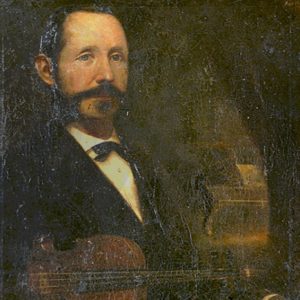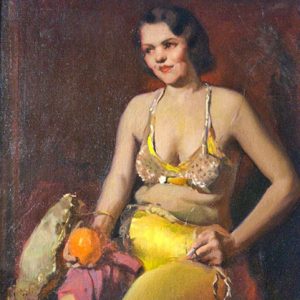calsfoundation@cals.org
Louis L. Betts (1873–1961)
Louis L. Betts was a painter active in the first half of the twentieth century in the United States, especially noted for his portraits. His handling of paint and the subjects he chose gave his work a grand and conservative quality, recalling Old Master paintings from the Baroque era as well as styles popular in late nineteenth-century European art centers.
Louis Betts was born in Little Rock (Pulaski County) on October 5, 1873, the son of Edwin Daniel Betts Sr., a landscape painter and his son’s first teacher. Young Louis’s mother died soon after his birth, and his father married one of her sisters. They did not remain in Little Rock long, however, for Betts’s three younger siblings (who all also had careers as painters) were born elsewhere: Edwin Daniel Jr. in St. Louis in 1879, Harold in Chicago in 1881, and Grace in New York City in 1885. A painting of a man holding a violin, Professor Armellini, now in the collection of the Arkansas Museum of Fine Arts, is said to date from Betts’s sixteenth year, when the work was done in exchange for violin lessons.
Betts entered the Pennsylvania Academy of Fine Arts in 1894, studying with William Merritt Chase, an important artist of the era, known for his portraits and pleasant scenes in an Impressionist style. A still-life of Betts’s entitled Oranges, in the collection of the Arkansas Museum of Fine Arts, is dated to 1889 and was perhaps a studio exercise. A portrait of the young Betts that was probably a classroom demonstration by Chase shows a studious figure wearing rimless glasses. Betts’s preference for portraits and genre subjects, as well as his loose painterly style, shows the effectiveness of his training with Chase. In 1902, he received a Cresson Traveling Scholarship, which allowed him an extended period of study in Europe, especially the Netherlands and Spain, where he learned much from studying the portraits of the seventeenth-century painters Frans Hals and Diego Velázquez. That study was undoubtedly at the suggestion of Chase, as they were models for his own work. Both artists are noted for their expressive brushwork and abilities to suggest a sense of vitality in their sitters.
Following his European studies, Betts returned to Chicago in 1906 but was living in the New York City area by 1910. In 1926, he was listed as living on 19th Street in New York City. He first exhibited at the National Academy of Design in 1902, and was elected an associate in 1912 and a full academician in 1915. He was an active member of this important national organization, winning prizes at a number of annual exhibitions (1902, 1918, 1931, 1932, 1933, and 1937) and serving on the organization’s governing Council from 1919 to 1922 and from 1930 to 1933. Betts’s success is also seen in his regularly exhibiting at the Salmagundi Club and the Century Association, both in New York, and also with the Allied Artists of America, an exhibition cooperative formed in 1914 in New York. Betts won a gold medal at the latter’s 1931 exhibition. He also won important prizes at the St. Louis Exposition (1904), Pittsburgh’s Carnegie Institute (1910), and the Art Institute of Chicago (1920).
Some of Betts’s subjects were prominent figures of the first half of the twentieth century in the United States, including author Booth Tarkington, art critic Royal Cortissoz, Drs. William and Charles Mayo, and William O. Goodman, founder of the Goodman Theater in Chicago. His portrait of the Illinois senator James Hamilton Louis was placed in the U.S. Capitol in 1940. The Art Institute of Chicago has an impressive pair of full-length portraits of Martin Ryerson and his wife (1912–13) that—in their emphasis on dark colors, plain backgrounds, and sense of presence—owe much to the Spanish Baroque artist Velázquez. The Ryersons were important collectors who gave much to the Art Institute. Also in Chicago is Betts’s 1905 portrait of the Art Institute’s director from 1879 to 1914, William Merchant Richardson French.
Betts’s Portrait of a Young Woman in a Bonnet (in the collection of the Arkansas Museum of Fine Arts) is probably an early work that reflects his study in Europe of eighteenth-century British portraits. An example of Betts’s impressionistic work is The Yellow Parasol (circa 1925, held at the Morris Museum in Augusta, Georgia), which uses the bright colors, loose style, and cheerful subject matter associated with the movement begun in France about the time of the artist’s birth. The full-length Rose Gown (circa 1939, held at the Richmond Art Museum in Indiana) may be a portrait of the artist’s first wife, Giovanna M. Kerzenknabe, whom he married in 1899. She died in 1935, and Betts married a friend’s widow, Zara Trevorrow Symons, two years later; their marriage lasted until Betts’s death.
Betts was listed as living in Bronxville, New York, at the time of his death on August 13, 1961. In addition to many other institutions, his work can be found in the museums of Toledo, Ohio, and Montclair, New Jersey, as well as at the Corcoran Gallery in Washington DC.
For additional information:
Falker, Peter, ed. Who Was Who in American Art. Madison, CT: Sound View Press, 1985.
Lublin, Mary. “Louis Betts.” In Paintings and Sculpture in the Collection of the National Academy of Design, edited by David B. Dearinger. New York: Hudson Hills Press, 2004.
Morgante, Karen A. “Louis Betts, Portrait Painter of High Society: The Meadow Brook Hall Portraits of Alfred G. Wilson, Matilda R. Wilson, Danny and Frances Dodge, and John F. Dodge.” Oakland Journal 1 (Spring 2000): 24–46.
Floyd W. Martin
University of Arkansas at Little Rock


 Louis L. Betts Painting
Louis L. Betts Painting  Circus Woman
Circus Woman 



Comments
No comments on this entry yet.